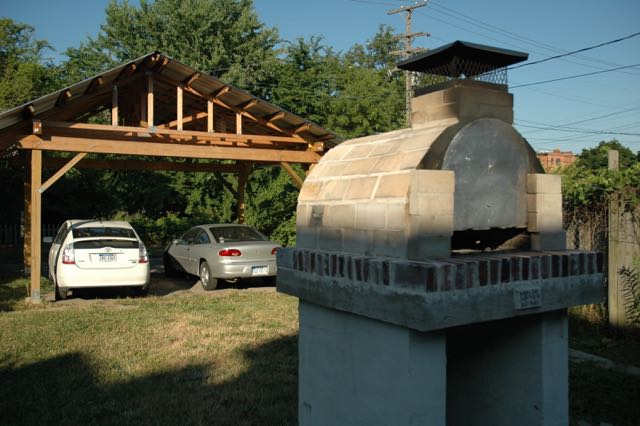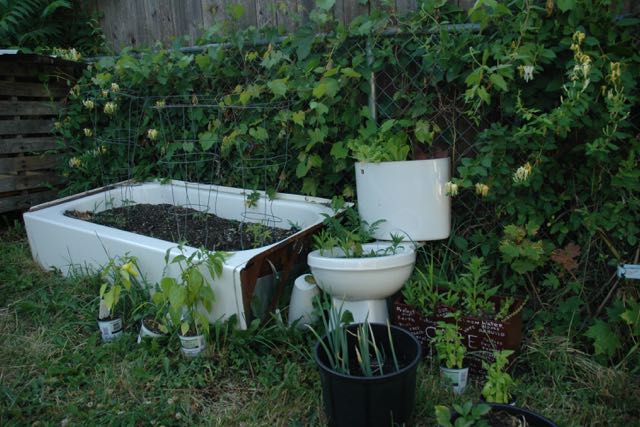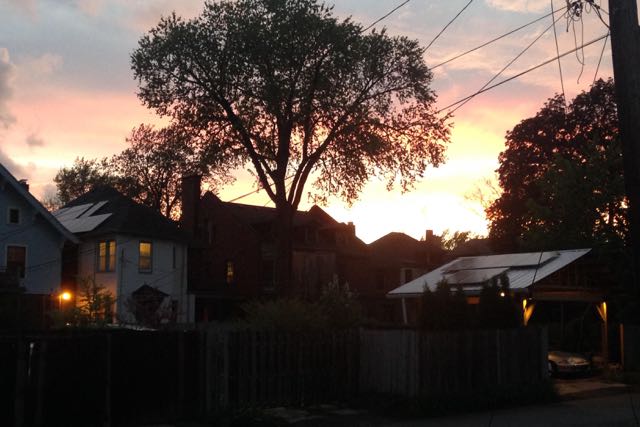The Eco-House: How a couple took green renovating to its limit
Jessica Meyer |
Wednesday, June 29, 2016
From the street, Alessandra Carreon and Drew McUsic's home in historic West Village looks similar to the rest on the block.
But a walk through their backyard reveals a greater, greener project: recycling and compost bins, a garden growing in an upcycled bathtub, an open carport for their electric vehicles, a large brick oven, rooftop solar panels. Their home is actually a pioneering example of sustainable living in Detroit.
While Carreon and McUsic grew up interested in sustainability, it wasn't until they met each other in college that their complementary passions grew. Carreon studied chemical engineering with a focus on the environment, and learned how taking care of the land enhances quality of life. By studying bio-engineering, McUsic learned how to intersect technology and biological systems in a sustainable, practical way.
Their paths lead them to Seattle, which was recently recognized as the country's most sustainable city. Living in a place where the people, city government, and infrastructure functioned cohesively was fulfilling. But they wanted to implement their passions in a place that didn't have a green reputation. That lead them to Detroit.
 Brick oven and carport
Brick oven and carport
Homeownership wasn't necessarily on the top of the priority list. But after realizing they wanted to live in the city long-term, they started their search.
"We wanted to put time, energy, and money into buying a house, creating a home, and establishing roots in the city," says Carreon.
They chose the West Village because Carreon worked on the east side doing sustainability-related programming with Detroit Public Schools for AmeriCorps. They bought their home in March 2013 and went to work on transforming it, taking the social and environmental costs into account at every turn.
"We wanted to maximize our positive effect on the environment with minimum negative effect," says Carreon.
With so many goals in mind, they originally hired a contractor, but learned that if they wanted to get things done according to their expectations, they'd have to do it themselves.
The first DIY project was floor renovation. They pulled up the carpet, recycled it, rented sanders from Home Depot, and applied a low-VOC (volatile organic compounds) polyurethane finish made with whey protein.
Because of their educational backgrounds, Carreon and McUsic recognize that health and environment are strongly linked. "When you sand or remove paint, you're causing chemicals, like lead, that have been in the paint or finish for decades to reenter the atmosphere," says McUsic.
Additional green renovations included using recycled glass tiles for the showers, dual flush toilets and low flow shower heads to conserve water, energy efficient heating and cooling systems, and replacing all fixtures with used ones. Most of what they bought was purchased locally from places like Habitat for Humanity ReStores, architectural salvage warehouses, and Craigslist.
 Upcycled bathtub and toilet
Upcycled bathtub and toilet
They even made counterintuitive, but environmentally responsible decisions such as buying their appliances new because products like Energy Star are more energy efficient.
In addition to upfront improvements, Carreon and McUsic focused on incorporating intentional behavior change. They recycle as much as possible, live with roommates, and drive electric cars.
 Nodding wild onion growing in the wild garden"All these decisions are incremental, but over the course of years they really add up," says Carreon.
These incremental decisions will also save money in the long-term. For example, The energy yielded from the solar panels gets returned to DTE's grid, after which Carreon and McUsic get credit based on the amount of energy they use versus the amount they produce. It will take eight years for them to pay off the installation loan, but after that they essentially never have to pay a utility bill again.
Carreon and McUsic have even more goals. To become truly net positive, they eventually want to install air-sealed windows and heat water through solar panels.
They also hope that their energy conservation can have implications beyond just their own home. Perhaps, once people see that sustainable choices are accessible and impactful, it will inspire whole neighborhoods to adopt their renovation and lifestyle practices.
One possibility is a communal battery filled with energy captured by solar panels from each house in a neighborhood. Then, if there's a brownout, every home connected to that battery would still have electricity. They'd also be making electricity communally, not paying for utilities, and even earning money from surplus electricity.
Nodding wild onion growing in the wild garden"All these decisions are incremental, but over the course of years they really add up," says Carreon.
These incremental decisions will also save money in the long-term. For example, The energy yielded from the solar panels gets returned to DTE's grid, after which Carreon and McUsic get credit based on the amount of energy they use versus the amount they produce. It will take eight years for them to pay off the installation loan, but after that they essentially never have to pay a utility bill again.
Carreon and McUsic have even more goals. To become truly net positive, they eventually want to install air-sealed windows and heat water through solar panels.
They also hope that their energy conservation can have implications beyond just their own home. Perhaps, once people see that sustainable choices are accessible and impactful, it will inspire whole neighborhoods to adopt their renovation and lifestyle practices.
One possibility is a communal battery filled with energy captured by solar panels from each house in a neighborhood. Then, if there's a brownout, every home connected to that battery would still have electricity. They'd also be making electricity communally, not paying for utilities, and even earning money from surplus electricity.
 Solar panels atop carport - Photo courtesy of Carreon and McUsic
Solar panels atop carport - Photo courtesy of Carreon and McUsic
"So many people see our solar panels and say 'What is that?' or 'I see you're generating electricity and I'd like to do that, too,'" says Carreon. "It's a conversation starter and visible symbol that people notice."
Carreon and McUsic helped found the West Village Sustainability Committee in 2014 to raise awareness in their neighborhood about the how to live in a more environmentally and socially responsible way. In May 2016, Eco-D, an initiative formed to help Detroit neighborhoods become "great and green," named West Village one of the first Eco Districts in the city.
In other words, their incremental decisions are already having an effect.
You can read more about Carreon and McUsic's home improvements in their blog.